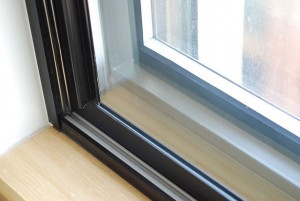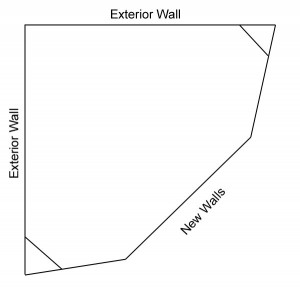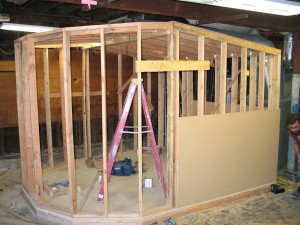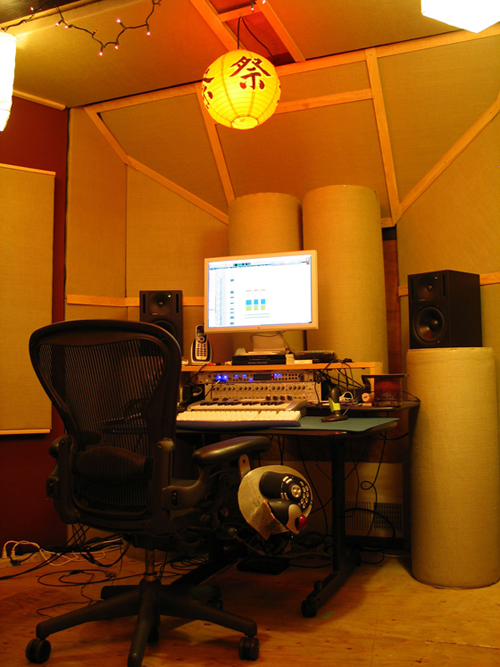Soundproofing the Small Studio
For one reason or another, whether it’s culture, commerce or community, people all around the world have huddled closer to one another with every passing year.
In 1900, fewer than 40% of Americans lived in and around urban areas. By the year 2000, that portion had nearly doubled, and today roughly 80% of Americans have collected together on about 3% of the total landmass in the U.S.
Unfortunately, many of our building and noise codes are vestiges of an earlier era, when the world was a little quieter and we were all a bit more spread out. Now many cities, New York included, have come to find that excessive noise is the new number one quality-of-life complaint.
For musicians and home studio owners, this buzzsaw cuts in both directions: When sound gets out, it can annoy neighbors and family members. When sound gets in, it ruins takes and breaks concentration.
Often, the best bet is to find an outside rehearsal or recording studio to book by the hour or by the month. But if you own your home or have a long-term lease and a little bit to invest, there are plenty of ways to improve the situation.
What Not To Do
The most common misunderstanding around soundproofing is the idea that acoustic foam panels can help stop sound from getting into or out of a room. In reality, that approach is about as effective as building a spacesuit out of strategically-placed napkins.
Although they may help improve the character of sound within a room, when it comes to blocking sound transmission, egg crates and mattresses don’t work, and neither do wall-mounted sheets of fiberglass. The truth is that there are only two things that can ever do the trick: Mass and Trapped Air. This can only be achieved through real construction with solid materials.
By far, the best way to soundproof a space is to build a “room within a room” – a new, freestanding floor, ceiling and set of walls that are sufficiently massive and decoupled from the original structure. This can be extremely effective, although not inexpensive. Even then, acoustics contractors like Jim Keller of Sondhus often say that there’s “really no such thing as soundproofing – at best, it’s more like sound resistance.”
But with that said, there are steps you can take to improve the “sound resistance” of your room without going all-out.
Where to Start: Doors and Windows
Sound is a lot like water. Wherever it can go, it will go.
If you have a sturdy massive wall, with even one flimsy area or a single air gap, sound will find its way to that weak spot and travel directly through it. The first place to look solve both these problems is your doors and windows.
Interior walls, which are usually made of a single sheet of drywall on each side of a supporting vertical “stud” may have an STC rating of about 33 dB. If you’re lucky, your exterior walls might cut out as much as 40 or 50 dB if they’re up to basic building code. But all too often, your doors may have an STC rating as low as 15dB, providing pitifully little sound protection.
Doors in apartment buildings, even ones that lead into communal hallways, are often entirely hollow. In many cases, they may literally be made of two pieces of flimsy plywood, kept from caving in on each other only by a lightweight honeycomb of corrugated cardboard.

Soundproof Window by http://www.cityproof.com. Photo by DumboNYC
Replacing a hollow door with a heavy solid-core wood door can go a long way to improving the overall performance of your room. But remember: it’s critical that the seal of the door be airtight, or sound waves will come screaming through whatever air gaps that remain.
Windows are another common weak spot. Replacing cheap windows with double-glazed glass can do a lot to block out street noise, as well as keep the temperature in the room more consistent.
If you have simple goals, like recording a few extra vocals or guitar overdubs at home without street and hallway noise interfering too much; or if you want to freely practice in your apartment without feeling self-conscious as your neighbors enter and leave the building, this step alone may go a long way in taking your room from useless to useable.
But for those who really need to block sound, this is just the beginning. Improving doors and windows can bring your whole room up to the spec of your walls, but they can’t take you beyond that point.
Soundproofing Walls
If the biggest problem you face is wall-borne sound transmission, replacing or reinforcing an existing wall can do a lot.
In the right scenario, basic upgrades using fairly inexpensive building materials can be surprisingly effective, particularly on interior walls. For the budget-conscious, simply adding another layer of drywall to each side of an existing single-layer wall can make for a measurable improvement.
If you’re able to remove the original drywall and stuff the cavity with basic pink insulation before you double up, this you can take the STC of an interior wall from 33dB up to as much as 45dB, making it competitive with the sound resistance of a basic exterior wall.
Further upgrades are possible as well. They involve additional construction and either A) using more standard materials and eating up more space, or B) switching to fancy boutique materials that cost significantly more, but allow greater isolation while eating up less room.
By sticking with standard building materials like regular gypsum drywall, wood studs and standard insulation, you can take the rating of a single interior wall from STC 33 all the way up to a respectable STC 63. You’d have to either stagger or double up on your studs, thus eating up valuable space, but the materials wouldn’t cost a whole lot – particularly if you only have one critical wall to replace or reinforce.
If you choose to use higher-cost building materials, you can easily achieve these STC ratings without losing any square footage. By replacing standard gypsum drywall with QuietRock, swapping out your wood studs for metal ones, switching your standard insulation out for Roxul, or adding in additional buffering materials like SheetBlock, Green Glue, or Resilient Channel and you can dramatically increase the performance of any wall without changing its basic dimensions.

Boutique construction products like QuietRock cost more, but allow greater STC while eating up less space.
Merely the act of swapping regular drywall for QuietRock can tack on additional 10-15dB in noise reduction, depending on the configuration. Even a mere 10dB drop is equivalent to reducing the sound power by 10 times, and is perceived by our ear as a halving of loudness. Of course, the stuff does cost about four times as much. But, if you choose something like QuietRock to make a simple double wall employing spaced studs and otherwise conventional building materials, you can easily approach STC 75 without adding much else.
Floors, Ceilings, Booths and a “Room Within a Room”
You can go one step further still and build a wall in front of your preexisting wall. If you don’t mind losing a few square feet, the effect can be significant, and the raw cost isn’t huge if you’re sticking to standard building materials.
Unfortunately, any amount of wall-based soundproofing – even if you reach an impressive STC 90 – is not going to do a lot for you if you have sound seeping in and out through your floor, ceiling or the structure of the building itself.
This is when floating floors and dropping ceilings becomes necessary. It’s a major construction job, but building a full-scale “room within a room” or even a small freestanding isolation booth is the only way to fully and effectively soundproof a space meant for regular music use. This is especially the case when you have neighbors above or below.
For many apartment dwellers, this is too costly an option. After crunching the numbers, you may find that that renting an outside rehearsal or studio space is the best bet for your needs. But if you’re lucky enough to have a basement space (especially one with brick or concrete exterior walls) there are some significantly more cost-effective options.

Under the right conditions, you can take advantage of two or three pre-existing exterior walls to create an isolation room on a modest budget.
Greg Stare, a regular drummer and occasional recordist, has built himself a few soundproofed practice and recording rooms over the years. When he built his latest space, which is set into the basement of a building in Greenpoint, he relied on the existing structure to do some of his soundproofing work for him.
Since the basement floors are concrete (a material with excellent sound-blocking properties) and since he has no neighbors below, Stare was able to go without floating his floors. And, since he had a real soild brick exterior wall he only had to build three more walls to create a drum room.
If you’re lucky enough to have two reasonably soundproof brick or concrete walls to draw on, things get even easier. All you have to do to create a large well-isolated booth is to find a corner, add just two sturdy, double-thick gypsum walls, and then rest a dropped ceiling on top of them. To cut down on parallel surfaces, you could even create a diamond-shaped booth in a corner like this one. Simply add three walls at 45-degree angles, rather than two walls at 90 degrees.
Dispensing with the need to build a floor and all the walls from scratch can cut the cost of creating a room-within-a-room literally in half. The isolation may not be absolute, but in Stare’s case, it’s been more than sufficient for daily use.“Just remember to include some way to vent the space,” he says. He learned that the hard way on his very first DIY buildout. His newest soundproofed room has an AC built in.
The materials for a build like this could cost in the high-hundreds rather than the thousands if you really scrimp and scrounge. But unless you’re prepared to do the entire job yourself, expect to set aside a good chunk of change for the help of a seasoned contractor.
Budgeting
“There is no average job,” according to Jim Keller of Sondhus. He’s a producer and mixer who has found regular work in helping musicians, recordists and everyday city-dwellers build quiet spaces, and he says everyone expects something different. But from the singer who wants to practice at home without being concerned about the neighbors listening in, to the engineer who wants to build a full-fledged home studio, he’s discovered that you can accomplish something at any reasonable budget.

San Francisco-based producer/engineer Count built a room within a room studio inside his one-car garage (inspired by listening to mixes in his car). The whole project (see ‘after’ pic below) was completed for $10K.
“What often works best is when the client comes to me with a budget and a goal,” he says. “Maybe it’s a drummer who has $4,000 to spend, and then we talk about what he can do with that, and how significant his results would be.”
There’s no strict minimum or maximum for any job, but when pressed for general parameters, Keller says that, “you probably couldn’t expect any real results for under $1,500 or $2,000.” As for the construction of something that resembles a real recording studio, he says you might expect to spend $25,000 or $35,000, “and even then were not talking about a very large one.”
Ultimately, there’s a range of options and goals, from replacing a hollow door for a little extra privacy, to building something like a truly isolated recording room.
In any event, the cost of meaningful soundproofing (which has nothing to do with gluing up some foam squares) usually ranges in the thousands – not the hundreds.
For those who want to create a sonic haven in their own home, the investment can sometimes pay off, whether it be in quality-of-life or in dollars. All it comes down to is an honest understanding of your needs, your budget, and the alternatives that are available to you
If you’re serious about soundproofing and want to know more, don’t rely on interweb hearsay. Reach out to a contractor who specializes in acoustic design, or pick up a book like Rod Gervais’ Home Recording Studio: Build It Like the Pros, or Jeff Cooper’s now-classic Building a Recording Studio
.
Justin Colletti is a producer/engineer, professor and journalist who lives in Brooklyn. He is a regular contributor to SonicScoop and edits the musician magazine Trust Me, I’m a Scientist.

Count’s completed studio. (Note the control system built into the right-hand side of his Aeron chair. More on that in a future article on creative studio ergonomics.)







Anthony
May 24, 2014 at 8:42 am (11 years ago)Creating a sound proof by building a room within a room can be inconveniencing though it can give one more chances of designing the inside room the way they want it……. for me this is so helpful i think i now got an idea of what i will do for my studio soundproof.!
Dan Kern
January 10, 2015 at 12:46 pm (10 years ago)Great article. Has really helped me plan for building my band room in my attached garage (brick wall on neighbor side, plaster wall on house side). Was hoping you could help me ensure I have enough soundproofing going on so that my neighbors (20 feet away) won’t be able to hear my music (at least inside their house). I used a decibel meter app on my iPhone to measure my max db and it’s @ 100db when drums and guitars are rocking. How far down do I need to get this db level (via soundproofing) so that my neighbors won’t hear? We are planning to use 2×6 studs to build a frame inside the garage and use either closed sell spray insulation or 3″ thick strips of pink insulation, double drywall with green glue in between the dry wall layers. We will also replace the door and make it airtight. Is this going to be enough? How many db will this reduce the sound (outside neighbors and inside house adjacent wall)?
FT27
November 3, 2016 at 9:37 pm (8 years ago)How did you go with soundproofing that space?
Bucky Nelson
March 26, 2016 at 1:04 am (9 years ago)Thanks for the information. It can be the best way to sound proof the walls. I have too go with acoustiguard for sound and vibration control devices. Yes this article is too helpful for me to get the best sound proofing solution.
Karina Babcock
March 29, 2016 at 10:58 pm (9 years ago)Loved the article! I just moved and have an enclosed garage under a ranch that I am trying to turn into my music room/studio for rehearsing/amateur recording of my flute quintet and other small ensembles that would include brass & woodwinds perhaps light percussion and private lesson instruction. The room I have has three cinder block walls (1 w/door to rest of basement and second w/bomb shelter alcove which is poured cement). The 4th wall is the closed in garage door end that appears to be stud wall with sheet rock.
My primary concern for sound transmission is the ceiling above which is floor to bedrooms. I know I will have to caulk with acoustical caulking as well as insulate. I am not concerned about transmission to outside since it is driveway end and neighbors aren’t that close. Any thoughts here?
I also would like the to put something on walls that help with energy insulation and enhance the acoustics of the space, but not add to sound transmission. What suggestions do you have?
Floor and outside walls have received US Open grade sealer, my next planned step was to install Dri-Core flooring to create moisture barrier and provide a sub-flooring to add flooring to. What is best floor material? Hardwood vs. laminate?
The plan is to add more outlets and heating (forced hot-water) to the space as well. Any thoughts & recommendations are welcome.
Do you ever take a video walk through of the space and give recommendations?